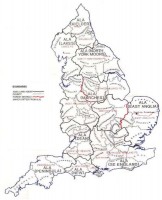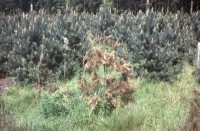 If you look at a Forestry Commission map of key spots in England, you might be surprised to see that Santon Downham is marked instead of cities such as London, Norwich, Cambridge or Ipswich. But the tiny village is the hub for all forestry activity for a huge area stretching from North Norfolk right down to East London. Over 20,000ha of Thetford Forest are managed from the purpose built 1960s office complex in Santon Downham, base to 95 staff .
If you look at a Forestry Commission map of key spots in England, you might be surprised to see that Santon Downham is marked instead of cities such as London, Norwich, Cambridge or Ipswich. But the tiny village is the hub for all forestry activity for a huge area stretching from North Norfolk right down to East London. Over 20,000ha of Thetford Forest are managed from the purpose built 1960s office complex in Santon Downham, base to 95 staff .
The village’s development in the 20th century has been shaped to a large degree by forestry, right from the 1920s when the run-down Downham Estate was bought. The landscape around the village evolved as the planting of Thetford Forest took hold New houses were built by the Forestry Commission, and occupied by its staff, and even the drinking water was provided by the Commission until 1998.
These days, few of the people who live in the village are directly employed in forestry, but it continues to have a major influence on the local economy, the local landscape – and even local gardens, as it provides the timber for much of the fencing and decking found in the garden centres and DIY stores around the area. Timber worth in excess of £4M is harvested from Thetford Forest each year.
 The way that the forest is managed has been changing. “No longer is it simply a task of growing trees for timber, as was our number one objective when we were established in 1919,” explains Forest Enterprise’s district manager Jim Lyon. “First and foremost, our job is land managers, managing the land for the people themselves.”
The way that the forest is managed has been changing. “No longer is it simply a task of growing trees for timber, as was our number one objective when we were established in 1919,” explains Forest Enterprise’s district manager Jim Lyon. “First and foremost, our job is land managers, managing the land for the people themselves.”
Land management brings with it many objectives, in particular dealing with communities, the people that live within those communities and the visitors that come from far and wide. “We manage the forest to take care of all of their aspirations,” he explains. Walking the dog, mountain biking, horse riding, motor rallying, archery and even husky sledge racing all take place within the forest . “We take pride in providing open access to the forest,” says Mr Lyon. “It is straightforward to control health and safety and environmental issues if you put a fence round the area and lock a gate but very different if you are a working forest, as we are, providing some 200,000t of timber a year.”
The priorities are with the social and environmental – the people and the habitat, he adds. “We manage our forest to provide quality timber for industry in balance with our other objectives of rural development, economic regeneration, recreation, access and conservation of our environment.”
Forest design planning has evolved over the last 10 years, in response to combining the needs of the public, the environment and the timber industry. This process enables the forest managers to:
- plan ahead and consider the consequences and costs of various actions
- enhance the environmental values
- create confidence in the timber market by producing a steady and sustainable supply
- resolve any problems that have been identified regarding conflicting activities
- create diversity in age structure, species and habitats where this is most beneficial
- work our operational methods to suit desired management objectives.
The forest has a diverse range of nationally rare plants and animals. Some areas are already designated as SSSIs for their wildlife interest and much of the forest is within the Brecks Proposed Protection Area due to high levels of two breeding bird species, the woodlark and the nightjar . These two heathland birds breed on areas recently cleared and replanted and their numbers have rapidly increased over the last 20 years. The forest also has many scheduled and unscheduled ancient monument from round barrows to flint mines and Roman villas. All of these interests will be taken into account during the forest design plan process.
But this is not the only, or indeed the main, driver behind the redesign. “The majority of the forest was planted in the 20s, 30s and 40s. It is all growing at the same rate and consequently is now mature or approaching maturity, which does not provide for diversity,” explains Mr Lyon. “We wish to restructure that, to provide trees of different heights, at different stages, to provide a variety of landscape views and many different habitats to cater for the conservation and ensure timber production is available at an even rate each year.”
Introducing more broadleaf varieties is not always appropriate; many types would not thrive in the sandy soils of the area. More broadleaf trees will be planted where the habitat is suitable – the idea is to provide a diversity of species.
 Most of the trees planted in the Forest are grown in Forest Enterprise’s nursery at Delamere, one of three in the country. Santon Downham used to have its own nursery, but it was closed in 1991 and production was moved to Delamere where investment in growing trees could be focused in a single location.
Most of the trees planted in the Forest are grown in Forest Enterprise’s nursery at Delamere, one of three in the country. Santon Downham used to have its own nursery, but it was closed in 1991 and production was moved to Delamere where investment in growing trees could be focused in a single location.
The balance between recreation and conservation has to be maintained. Whilst encouraging visitors on foot, bicycle and horseback to use the miles of forest tracks, the interests of wildlife such as the red squirrel need to be considered. The High Lodge centre – which lies within the boundaries of Santon Downham – has over 150,000 visitors a year and has a range of facilities including adventure play areas and a maze. It is also used for open air concerts during the summer . Adjacent to the visitors centre is the red squirrel conservation area where specific woodland management maintains the best possible habitat for these elusive and increasingly rare animals.
“Listening to the needs and aspirations of the community and our customers is a very important part of the planning for the new design,” says Mr Lyon. The process of redesigning the forest started some 10 years ago – a revision is now under way. International, European and British policies and thinking feed into the process. “Before we fell, we are planning 25-50 years ahead,” he adds.
Consultation involves local authorities, English Nature, customers and the regulatory and advisory side of the Commission. Design plans will be shown through public roadshows. “This is not a fait accompli,” emphasises Mr Lyon. He also welcomes the involvement of the Friends of Thetford Forest, an enthusiastic volunteer organisation, which is increasing in strength and gives a very good sounding board. “They speak their minds, which is excellent,” he says.
Timber from Thetford Forest goes to many different markets including construction, fencing and pallet manufacture. Smaller diameter material is used in the manufacture of chipboard. Fencing is the most important market locally and the popularity of timber products such as decking is also clearly evident as a visit to most garden centres will reveal. Both Jeffrey Walker and MR Ellis supply sawn timber into the market place as do a number of smaller mills in the area. For many of these customers it is important that they can trace back the source of supply to a well managed, sustainable woodland. All Forestry Commission forests have recently received accreditation under the UK Woodland Assurance Scheme.
This scheme audits all aspects of an owner’s management of its woodlands, taking into account a whole range of measures which demonstrate environmentally friendly and sustainable management practices.
Address : <http://www.santondownham.org/ForestryPeople.html>
Date Visited: Sun Mar 06 2016 08:47:04 GMT+0000 (GMT Standard Time)
Staff based in Santon Downham carry out a multitude of roles – some of the men and women work as recreation or conservation rangers, others deal with forest mangement, harvesting, marketing, administration, provision of roads or as mechanical engineers looking after the harvesters and vehicles. There are also staff at offices in North Norfolk, Sandlings, Lavenham and in the east end of London. In all, the region employs about 95staff – 90 based in the village – though contractors add to the numbers working in the forest.
Forest Hub
Santon Downham is the district office for an enormous area, stretching from North Norfolk to London, and therefore plans made in the village manifest themselves in developments far afield.
Forestry People
 Staff based in Santon Downham carry out a multitude of roles – some of the men and women work as recreation or conservation rangers, others deal with forest mangement, harvesting, marketing, administration, provision of roads or as mechanical engineers looking after the harvesters and vehicles. There are also staff at offices in North Norfolk, Sandlings, Lavenham and in the east end of London. In all, the region employs about 95staff – 90 based in the village – though contractors add to the numbers working in the forest.
Staff based in Santon Downham carry out a multitude of roles – some of the men and women work as recreation or conservation rangers, others deal with forest mangement, harvesting, marketing, administration, provision of roads or as mechanical engineers looking after the harvesters and vehicles. There are also staff at offices in North Norfolk, Sandlings, Lavenham and in the east end of London. In all, the region employs about 95staff – 90 based in the village – though contractors add to the numbers working in the forest.
Taking the Long View
Forestry involves waiting many years before the timber can be harvested. The rotation period for the softwood pine trees in Thetford Forest is about 50-55 years.
Technology
Thetford Forest has been captured on a geographical information system, explains planning forester Richard Brooke, who is based in the district office in Santon Downham.
Friends of the Forest
 Friends of Thetford Forest Park was inaugurated in 1995. Its aims are to increase knowledge, understanding and enjoyment of Thetford Forest Park, as well as to encourage involvement of the local community.
Friends of Thetford Forest Park was inaugurated in 1995. Its aims are to increase knowledge, understanding and enjoyment of Thetford Forest Park, as well as to encourage involvement of the local community.




